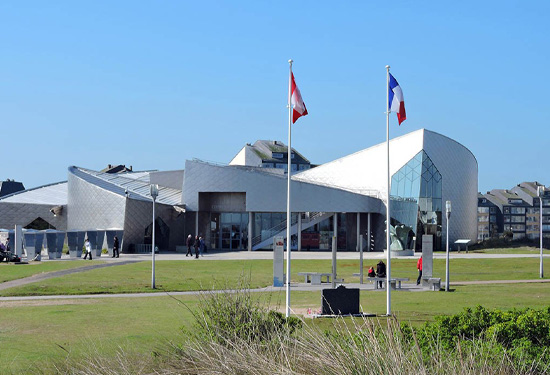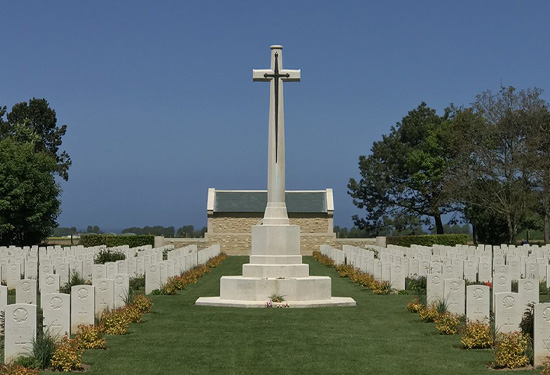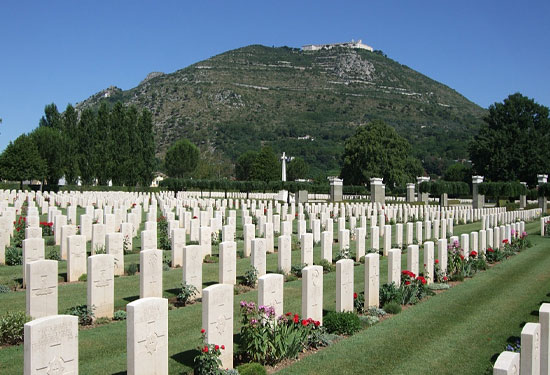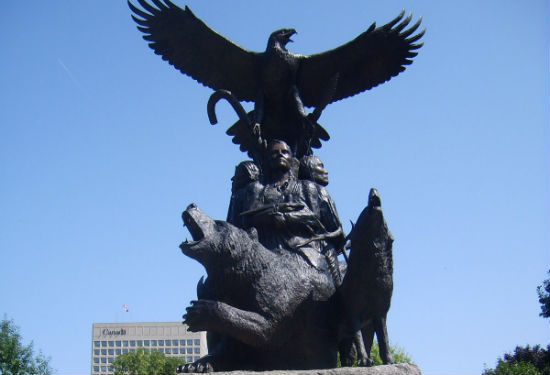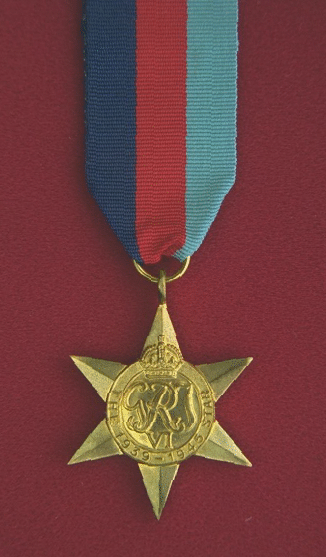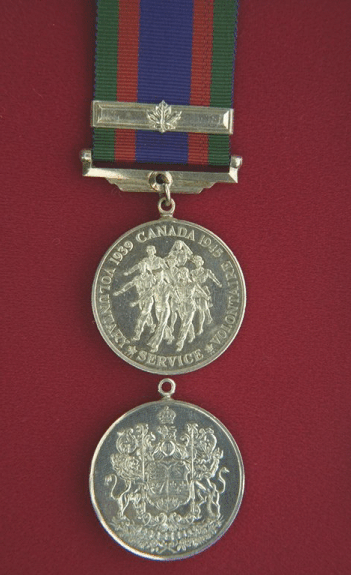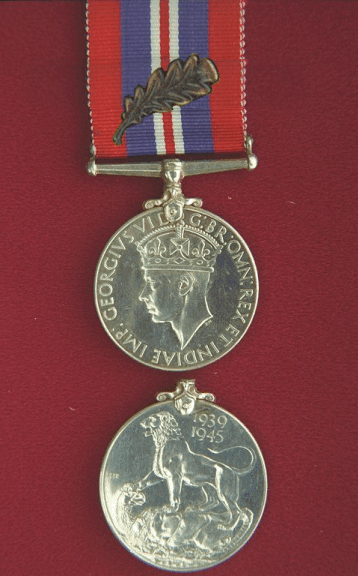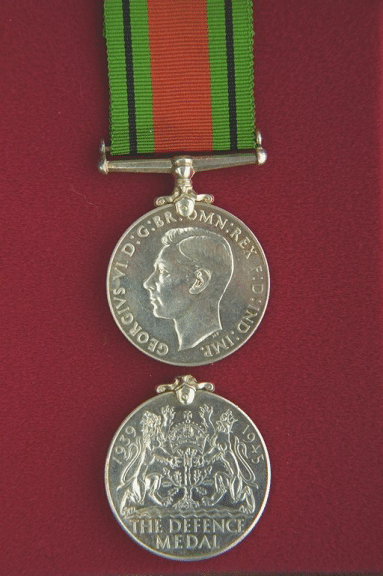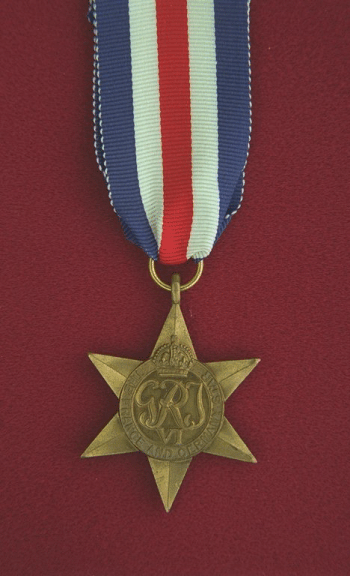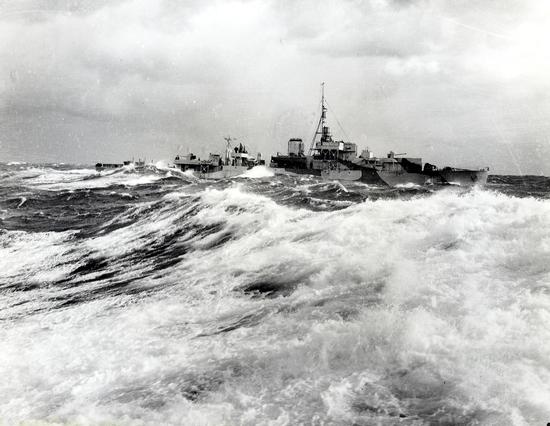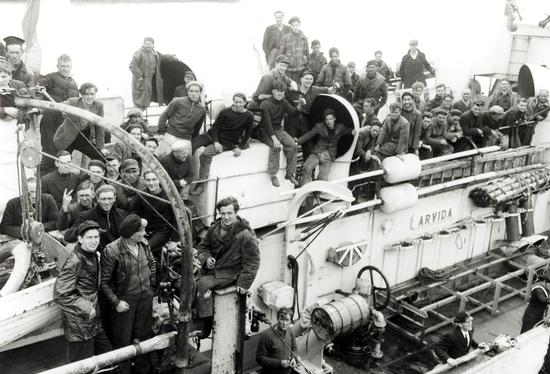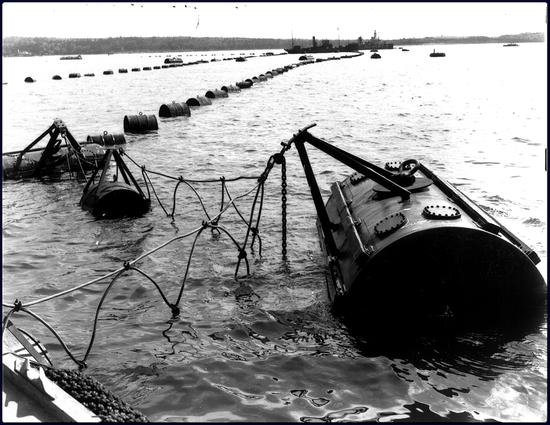
Battle of the Atlantic
Canadian naval and air forces helped protect the vital flow of Allied shipping across the Atlantic.
3 September 1939 - 8 May 1945
Second World War
Table of contents
Section 1
Section 2
Section 3
Classroom materials
Introduction
What a miserable, rotten hopeless life... an Atlantic so rough it seems impossible that we can continue to take this unending pounding and still remain in one piece... hanging onto a convoy is a full-time job... the crew in almost a stupor from the nightmarishness of it all... and still we go on hour after hour.
Frank Curry of the Royal Canadian Navy (RCN) wrote these words in his diary aboard a corvette in 1941, during the Battle of the Atlantic, a battle that would be called the longest of the Second World War. During the darkest days of the war, thousands of Canadians in the RCN, the Canadian Merchant Navy, and the Royal Canadian Air Force (RCAF) faced perilous conditions that many of us can only imagine. The following account tells a tale of incredible bravery and sacrifice which all of us have a duty not only to remember but to pass along to future generations.
The first convoys
From the very outset of hostilities in the Second World War in 1939, the Atlantic supply route from North America to the United Kingdom was threatened. Eventually gaining control of the entire coast of Europe, from the northern tip of Norway to the Pyrenees, the Germans set out from every harbour and airfield in western Europe to sever the lifelines to Britain.
For six long years the RCN, the Canadian Merchant Navy and the RCAF were central participants in what was to be known as the Battle of the Atlantic.

View from R.C.A.F. aircraft of convoy merchant ships in the North Atlantic. Photo: National Archives of Canada/PA 115005
Hazardous conditions
The sea lanes of the North Atlantic formed a grim battleground. Navigation was hazardous, and sailors in the navy and merchant marine died not only from enemy attack, but from exposure and accidents in the fog and winter gales. Nor was protection sufficient to prevent heavy losses. There were too few naval vessels and maritime patrol aircraft available, as well as a severe lack of training and modern equipment and technology.
In 1939, Canada possessed only a few dozen Canadian-registered merchant ships, six destroyers, five small minesweepers, two training vessels, and a single squadron of modern military flying boats. No one would have predicted that, from this tiny beginning, Canada's forces would go on to play a large and significant part in the Atlantic war, and that the Canadian Merchant Navy would carry cargoes around the world.
Canadian assistance
Bridging the Atlantic was the key to strategic supply, and it was in maintaining the Atlantic lifeline that Canadian naval and air personnel played an increasingly vital role. To transport safely the vast amounts of goods and troops that were needed, ship movements had to be organized and controlled. In August 1939, Canadian-registered merchant ships and ships in Canadian ports passed from the control of their owners into the control of the RCN, which would determine routes and departures. Shipping on the more important and vulnerable routes was placed in convoy as the best means to regulate traffic and provide protection from both sea and air.

Anti-submarine net between Fort York Redoubt and McNabs Island, Halifax NS. May 1942.
On September 16, 1939, the first convoy set out from Halifax for the United Kingdom, closely guarded by HM cruisers Berwick and York and by the Canadian destroyers St. Laurent and Saguenay. Soon, two convoys a week were sailing from Halifax. By the end of 1939, some 410 ships in 14 HX convoys had crossed the Atlantic. Escort work would remain the RCN's chief responsibility for the duration of the war. It was difficult and dangerous work and Canadians shared in the worst hardships experienced in the war at sea.
The early battles
In April 1940, the war in Europe took an ominous turn as German troops without warning seized Denmark and launched an invasion of Norway. In only a few weeks the Germans had conquered Denmark and Norway and isolated Sweden.
On May 10, Germany launched its blitzkrieg against Holland, Luxembourg, Belgium and France. With German troops pressing from all sides, the Allied troops in Europe were forced to the Channel at Dunkirk with the sea as the only hope of escape. On June 22, 1940, France surrendered, and Britain and its dominions stood alone against a formidable enemy.
Although the United Kingdom proved victorious in the Battle of Britain and managed to stave off Hitler's planned invasion, it remained under siege. London, many British cities and the English Channel ports were bombed unmercifully, and the U-boats, using their brand new bases in France, attacked convoys and independently-routed ships almost at will. The U-boats picked off solo ships and stragglers and made bold, single-handed attacks on convoys. These young aces, the German elite, raced each other for tonnage sunk. German naval commanders later referred to the period July to September 1940 as "the happy time."

Torpedo explosion damage to port lower side of hull of SS Fort Camsun. LAC PA190186
Desperate times
In September of 1940, for the first time, U-boats began using the so-called "wolf-pack" tactics. At night, groups of U-boats (often as many as six and sometimes more) attacked convoys sailing from North America to Britain. The results were calamitous. As many as 20 per cent of a convoy's heavily-laden cargo ships were sunk.
Meanwhile, the blitz on London went on night after night to shatter its enormous port. The Channel was closed to shipping by October and all Atlantic convoys were rerouted north of Ireland to Liverpool and the Clyde in Scotland. Even this route was seriously threatened and four RCN destroyers, which had been stationed in British waters after France was invaded, strove to fend off submarine attacks while rescuing survivors of torpedoed merchant ships.
The shipping losses were staggering and British shipyards were heavily committed to naval construction. Great Britain could not produce new merchant ships at the pace needed to replace those being lost and turned to the United States and Canada. In the face of the urgent need, Canada embarked on a massive shipbuilding program. However, before these ships could come off the assembly lines, the Atlantic war grew more desperate.
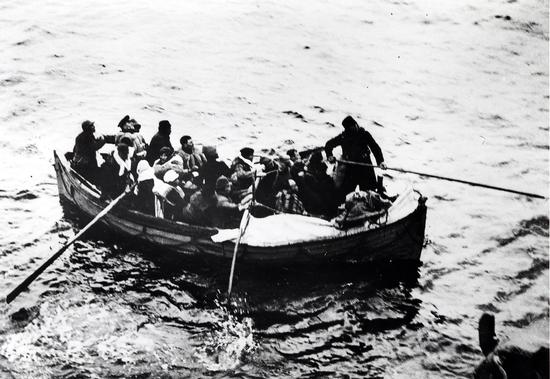
Survivors of torpedoed merchant ship aboard HMCS Arvida, St. John's, Nfld., September 1942. LAC PA136285
The war intensifies - 1941
With the approach of the spring of 1941, the enemy stepped up the scale of attack. In June alone, more than 454,000 tonnes of shipping were lost to U-boats.
To counteract this menace, new types of vessels were constructed and scientists worked desperately to design new methods of locating and destroying the U-boats. Canada's fleet was augmented by several new types of vessels, of which the corvette was the most famous. Designed on the pattern of a whaler, it was 63 metres long, displaced 935 tonnes and had a maximum speed of 16 knots. They could be produced quickly and cheaply and had the ability to outmanoeuvre a submarine. However, corvettes were known as "wet ships." They had been designed for coastal patrols and were pressed into transatlantic service only because there was nothing else available. As the seas broke over them, salty water seeped through seams, hatches and ventilators. They were intolerably crowded and living conditions on board for a crew of some 60 sailors were terrible. Nevertheless, these small ships were invaluable in the anti-U-boat war. Of the 123 corvettes that served in the RCN, ten were lost to enemy action.
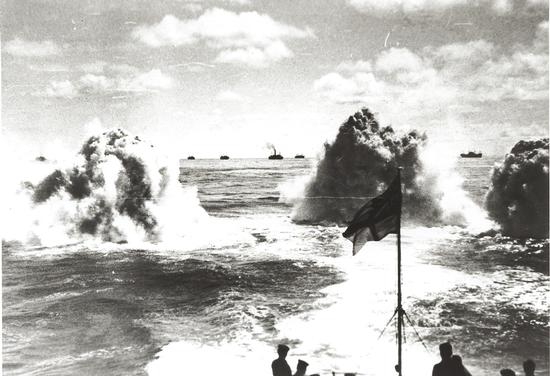
Depth charges being dropped by HMCS Saguenay. Photo: Library and Archives Canada PA 116840
Bases and patrols
As enemy U-boats began to probe farther west, the British countered by establishing new bases for ships and aircraft in Iceland and Newfoundland. The Newfoundland bases would become a Canadian responsibility. On May 31, 1941, Commodore Leonard Murray, RCN, was appointed commander of the Newfoundland Escort Force reporting to the British Commander-in-Chief, Western Approaches. A few days later, the first Canadian corvettes joined his command. In June, Canadian destroyers in British home waters returned to serve with the Newfoundland force. By July, the Newfoundland Escort Force totalled 12 groups of Canadian and British warships and was escorting convoys as far as 35 degrees west.
The Royal Canadian Air Force (RCAF), meanwhile, had been flying patrols over Newfoundland's waters and coasts since 1939 and the first maritime patrol squadron had been stationed at Gander since 1940. Reinforced by other RCAF squadrons, it now provided air support to the Newfoundland Escort Force and was an integral part of the RCAF's Eastern Air Command. In the eastern Atlantic, the convoys were guarded by the Royal Air Force (RAF) Coastal Command which included RCAF squadrons. At this time, however, aircraft lacked the range to cover the central part of the Atlantic ocean, an area that became known as the "Black Pit" because of the heavy losses the U-boats were often able to inflict there.
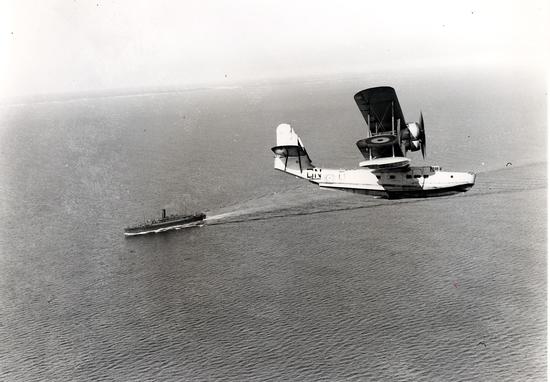
Supermarine Stranraer flying boat of the RCAF escorting convoy, 3 April 1941. Photo: Veterans Affairs Canada 692
The campaign moves to North American waters
Although officially neutral, the United States had become increasingly involved in the war at sea. In September 1941, Canadian naval forces came under American "co-ordinating supervision." This arrangement replaced control by the British commander-in-chief, based in England, with an American commander who was much closer to the situation in the western Atlantic. However, when the United States officially entered the war in December 1941 following the Japanese attack on Pearl Harbor, many of the American ships were withdrawn from the North Atlantic to meet burgeoning U.S.commitments elsewhere. This, unfortunately, weakened the Atlantic anti-submarine defences.
As winter storms began to batter the convoys, marine casualties from causes other than enemy action also rose steadily.
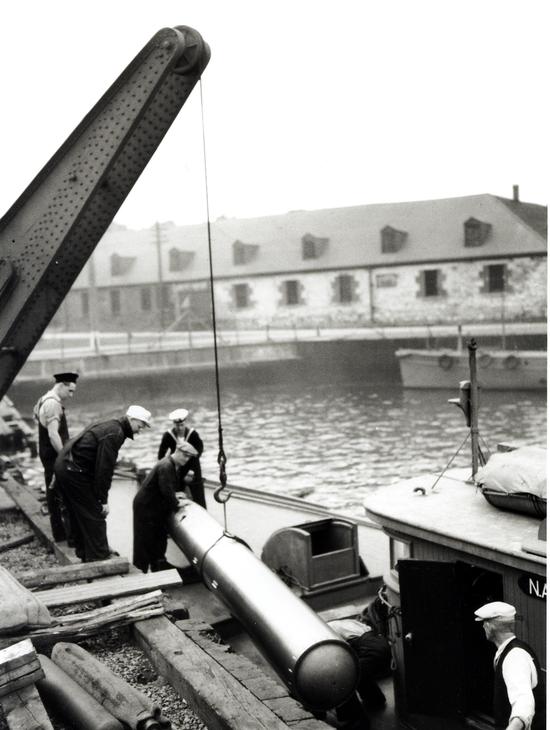
Personnel handling torpedo in HMC dockyard, Halifax. LAC PA104147
German U-boats
In January 1942, the Battle of the Atlantic shifted to the Canadian and American seaboards where Admiral Karl Dönitz, head of German U-boat forces, suspected shipping would be poorly protected. The Canadian navy, however, now with more than two years experience in organizing convoys, immediately began to sail shipping in defended groups. Often the only protection available was a single armed yacht. It worked. The U-boats soon shifted their main offensive to the U.S. coast and the Caribbean where ships were still sailing alone.
It became another "happy time" for U-boat commanders as the U-boats wreaked havoc along the American coastline.
The Triangle Run
Night after night submarines rose to the surface and picked off merchant ships at will, many of them silhouetted against the undimmed lights of the shoreline. From January to July 1942, nearly 400 ships were sunk for the loss of only seven U-boats. Through the spring of 1942, the U.S. Navy gradually built up a convoy system, but was dependent on Canadian help. Canadian escorts, reinforced by some Royal Navy ships, escorted much of the transatlantic shipping from New York north. This was the Triangle Run, in which the Canadian escort groups shuttled convoys between New York or Boston, Halifax, and the eastern part of Newfoundland, where the Canadian and British mid-ocean escort groups took over the run to the British Isles. Other Canadian warships assisted the British and Americans in protecting the valuable tanker traffic from the Caribbean.
The Gulf of St. Lawrence
While the RCN and RCAF had been able to limit losses off Nova Scotia and Newfoundland during the first half of 1942, there was still a very large vulnerable area: the Gulf of St. Lawrence. The huge commitments on the ocean shipping routes, moreover, left very few aircraft and almost no warships to defend this inland sea. On the night of May 11, the freighters SS Nicoya and SS Leto were torpedoed off the Gaspé Peninsula. The war was suddenly right at home and in sight of shore.
Sinking of the Caribou
Once again, the navy organized convoys and the air force kept as many aircraft overhead as they could. These efforts made the great strain on the forces nearly unbearable but the U-boats continued to take a toll. The constricted shipping routes, the many deep-water hiding places, and the virtual blindness of underwater detection equipment in the complex waters of the Gulf and river seemed to make tested defence methods ineffective. By early October, seven U-boats had sunk two naval escorts and 19 merchant vessels in the Gulf and river. Then, on October 14, the ferry Caribou was sunk just 64 kilometres short of her Newfoundland destination. Of 237 passengers, 136 men, women and children perished.
The disaster seemed to confirm the wisdom of the navy in its decision a few weeks before to close the Gulf to overseas shipping. The immediate cause for this development had been yet another plea from Britain for more Canadian escorts for yet another new commitment — to support the Allied invasion of North Africa. These ships could only be provided by reducing the force in Canadian waters, and the naval presence in the Gulf was scaled back because of the problems encountered in defending against the U-boats. Paradoxically, the German records now available show that the Canadian air force and navy operations had by October almost completely discouraged the U-boats. The hit on Caribou had been a tragic piece of good luck for a U-boat that had almost given up the hunt in the Gulf.
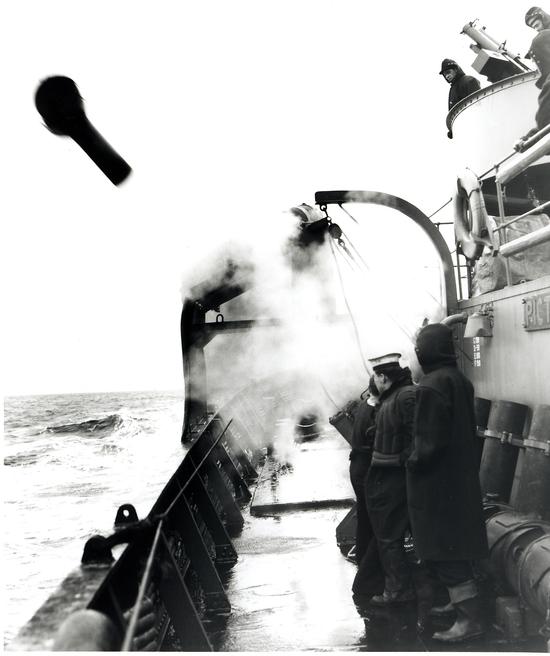
Anti-submarine grenade launched into the air by the corvette HMCS Pictou during submarine attack, March 1942. LAC PA-116838
The grimmest period
While taking on the new responsibilities on the North American coast and in the Mediterranean, the RCN also maintained a major presence on the transatlantic run between Newfoundland and Northern Ireland. Moreover, they were often responsible for the slowest convoys, the ones most likely to fall victim to U-boat attacks. During the summer and fall of 1942, as Dönitz scaled back the offensive in Canadian and U.S. waters because of improved defences there, he concentrated large numbers of submarines in the mid-Atlantic. Despite bombing raids on German construction yards and bases, the U-boat force increased. In the fall of 1942, with nearly 300 submarines available—over ten times as many as at the outbreak of war—Dönitz was able to send 20 or more against a single convoy.

Maps indicating Merchant Ship Losses in the Atlantic from Jan 1, 1942 to July 31, 1942 and Aug 1, 1942 to May 31, 1943
“Wolf packs” and the “Black Pit”
At first, the Canadian groups held their own, but as the size of the “wolf packs” increased and winter storms swept the Atlantic, several convoys escorted by the RCN suffered heavy losses. Canada's navy had expanded rapidly. By late 1942, the RCN had 16,000 members serving in 188 warships, a number that was still too few for the enormous commitments. The strain told in the performance of the Canadian groups, which could not be reinforced adequately or supplied with the latest weapons or advanced training programs. The RCAF's Eastern Air Command did its best to help the beleaguered convoys pushing its aircraft to the limits. The Canadian airmen achieved outstanding results on several occasions, destroying and damaging U-boats 500 miles and more out in the Atlantic. They did not, however, have the latest “very-long-range” aircraft needed to reach the dreaded “Black Pit” where the U-boats could attack in relative freedom.
The Battle of the Atlantic reached its climax in March 1943; in that month, the U-boats sent 108 Allied ships—569,000 tonnes of vital shipping—to the bottom. These figures were lower than in November 1942, but what was so disturbing was that 85 of the ships lost had been in convoy or straggling and most had been sunk in the North Atlantic. The only glimmer of hope lay in the success of the air and naval escorts in exacting a toll of 16 U-boats.
The tide turns
The U-boat success threatened the war plans of the western alliance. Dependable delivery of troops, equipment and supplies were vital to build up forces for the liberation of Europe. An all-out Allied effort, especially by the British, against the submarines was needed. In May 1943, outstanding defence of convoys compelled Dönitz to change his U-boat strategy in the North Atlantic.
This was not, however, the end of the U-boat menace. Dönitz still had more than 200 submarines, and German industry and science was rapidly replacing losses and providing improved equipment. The RCN continued its rapid expansion, but now with better equipment and improved ships. For example, large Canadian-built frigates, unlike the little corvettes, were expressly designed for trans-ocean escort. The RCAF's Eastern Air Command also received better aircraft in the last half of 1943, including very-long-range Consolidated Liberator bombers that could—and did—make patrols right across the Atlantic, helping to close the “Black Pit.”
In addition, three RCAF anti-submarine bomber squadrons had been organized in the Royal Air Force's Coastal Command to carry out patrols from Great Britain. Many RCAF personnel also served in British anti-submarine squadrons. Thus the RCAF, like the RCN, had a major presence across the whole Atlantic. Other technological developments helped the Allied cause as well, with new weapon, radar and code-breaking developments contributing to the turning of the tide against the U-boats.
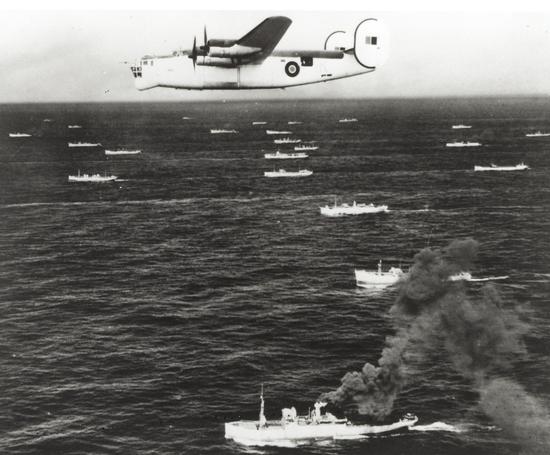
A Consolidated VLR Liberator provides air-cover for a transatlantic convoy. LAC PA107907
The Normandy invasions
Both Canadian services took on an increased share of convoy defence in the North Atlantic to release British warships and aircraft to prepare for the Allied invasion of France. During the last months before the Normandy invasion, the RCN assumed responsibility for all North Atlantic escort. Canada's now very substantial and capable anti-submarine fleet and air squadrons also played a prominent part in protecting the Allied invasion fleet as it crossed the English Channel. Canadian air and naval units were among the most successful among the Allied forces in finding and destroying U-boats during and after the invasion.
Yet, the U-boat fleet continued to launch new offensives. New snorkel technology, for example, enabled the submarines to operate continuously underwater and allowed them to hover close off the entrances to British and Canadian ports. Although the U-boats were unable to regain the initiative, they had significant successes until the very end of the war. A stealthy snorkel U-boat sank the minesweeper HMCS Esquimalt just off the entrance to Halifax harbour on April 16, 1945.

View from LCI(L) 306 of the 2nd Canadian (262nd RN) Flotilla showing ships of Force 'J' en route to France on D-Day.
The achievement
Canada's role in the Battle of the Atlantic was large and significant. Starting from a tiny base of ships, aircraft and personnel, and an infrastructure of meagre proportions, Canada became one of the foremost Allied powers in the Atlantic war. By 1942, Canada was able to carry a major share of the defence of North American waters and, at the same time, was Britain's principal partner in the defence of trans-ocean convoys. By 1944, Canadian forces had developed the strength and capability to provide a significant contribution to the British and Americans in other theatres of the war.
Canada's Merchant Navy Veterans bore much of the brunt of the war in the Atlantic. Many of the sailors aboard merchant vessels had survived the mines and submarines of the First World War and chose to sail again, some two decades later. They sometimes sailed in rusty old ships, but more often in highly inflammable tankers or in freighters loaded with ammunition. With each voyage the odds of survival seemed to grow longer. Still, voyage after voyage, men who had been torpedoed or had seen ships go down about them, sailed and sailed again.

Escorts and merchant ships at Hvalfjord, Iceland, before the sailing of Convoy PQ 17 to Murmansk. Photo: Imperial War Museum A-8953
The RCN and RCAF contributions
The most important achievement of the war in the Atlantic was the more than 25,000 merchant ship voyages made from North American to British ports under the escort of Canadian forces. These vessels delivered approximately 165 million tonnes of cargo to sustain the United Kingdom and made possible the liberation of Europe. In the process, Canadian warships and aircraft sank, or shared in the destruction of some 50 U-boats.
Beginning the war with a mere 13 vessels and 3,500 personnel, the Royal Canadian Navy grew to become one of the largest navies in the world. At war's end, the RCN comprised 373 fighting ships and more than 110,000 members, including 6,500 women who served in the Women's Royal Canadian Naval Services. The principal Canadian anti-submarine forces at that time included 261 sea-going escorts (Bangors, corvettes, frigates and escort destroyers). Hundreds of other craft—Fairmile launches, tugboats, coastal tankers and the other kinds of transports—protected Canadian waters, serviced the fleet and kept the bases running. All but a handful of the RCN ships, moreover, were built in Canada—an accomplishment of critical importance to the Allied cause. During the dark years of 1941 and 1942, when Canadian production came on stream, the larger Allies simply had no other source of escorts.
The RCAF's Eastern Air Command reached a peak strength of 21,233 personnel, including 1,735 members of the Women's Division, at the end of January 1944. Of this total, more than 1,200 were air crew. The rest managed the bases, communications, navigation systems and other services needed to operate multi-engine aircraft over the vast expanse of the northwest Atlantic. At this same time, nearly 2,000 RCAF air crew were serving in both Canadian and British squadrons of the Royal Air Force Coastal Command.
The main objective of Canada's Atlantic forces was always the protection of shipping. The outcome of the war was dependent on the success of the Atlantic convoys—on the merchant ships reaching the United Kingdom.

Escorting captured German U-190 submarine from Bay Bulls to St. John's, Nfld., June 1945. LAC PA140825
Growth of the navy
In 1939, Canada had only 38 ocean-going merchant ships averaging little over 6,000 deadweight tonnes (dwt), with a total of about 290,000 tonnes and manned by approximately 1,450 Canadian seamen. Following the outbreak of war, captured enemy ships and ships of occupied nations were added to the roster. There was also a large Canadian Lake fleet, and in the desperate wartime situation even they became ocean-going vessels. Yet, over the course of the next six years, the wartime world's fourth largest merchant navy would emerge, almost all of it built in Canadian shipyards.
The number of ships that poured from Canada's shipyards during the war was extraordinary. In fact it was described by an official of the British Ministry of War Transport as "remarkable," "astonishing" and "magnificent." From the first delivery in December 1941 to shortly after war's end in 1945, Canada produced three hundred fifty-four 10,000 tonne dwt cargo ships; forty-three 4,700 tonne dwtcargo ships; and six 3,600 tonne dwt cargo ship. Simultaneously, they turned out astonishing numbers of naval vessels; 281 escort ships (destroyers, corvettes, frigates), 206 minesweepers, 254 tugs and 3,302 landing craft.
The remarkable achievement by the Allied shipyards was an important reason for the turn of the tide in the Battle of the Atlantic. By mid-1943, it was clear that no matter how many merchant ships German U-boats still could send to the bottom, torpedoings could no longer outpace the production of new ships.

Frigate HMCS Swansea, January 1944. LAC PA107941
The cost of war
With this expanded participation came a high cost. Approximately 2,000 members of the RCN were killed, all causes and theatres combined, the vast majority in the Battle of the Atlantic—752 members of the RCAF died in maritime operations as a result of enemy action and flying accidents in the unforgiving environment. The Book of Remembrance for the Merchant Navy lists by name nearly 1,600 Canadians and Newfoundlanders, or those who served on ships of Canadian or Newfoundland registry. It includes the names of eight women. Many other Canadians, whose names are unknown, were lost serving on ships of Allied merchant marines.
Those who fought in the Battle of the Atlantic achieved and sacrificed much in their efforts to help bring peace and freedom to the people of Europe. These combatants were among the more than one million men and women who served in Canada's armed forces during the Second World War. More than 42,000 Canadians gave their lives in the war. Canada recognizes the sacrifices and achievements of all the Canadians, like those who fought in the Battle of the Atlantic, who accomplished so much and left such a lasting legacy of peace.
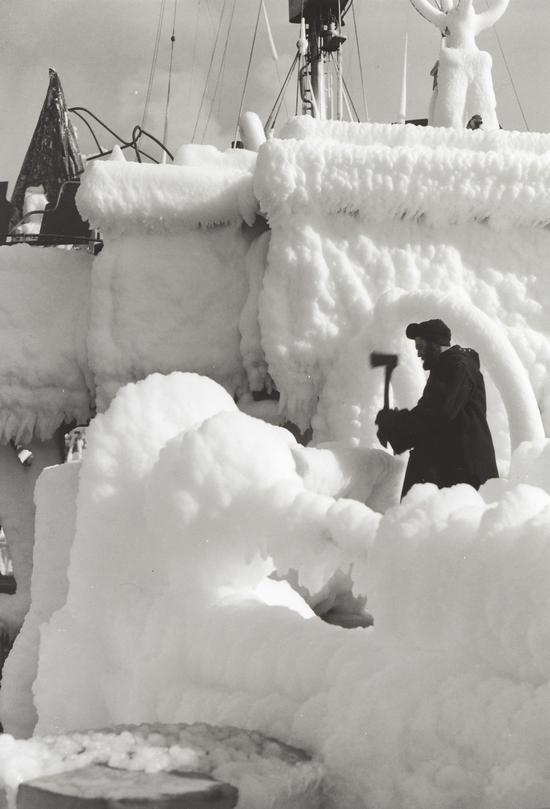
HMCS Brantford covered with ice, February 1944. Photo: Library and Archives PA-136146
A significant Canadian contribution
The Battle of the Atlantic was a pivotal struggle that was won, just in time, with massive help from Canada—from its navy, its airmen, its merchant marine and from its civilian population.
A Victoria Cross, the British Empire's highest gallantry medal, was posthumously awarded to a member of the RCAF for his courageous leadership during the Atlantic campaign. Flight Lieutenant David Hornell, of Mimico, Ontario, was pilot of a Canso amphibian aircraft which came across a surfaced U-boat north of the Shetland Islands in June 1944. Although his aircraft had been hit by anti-aircraft fire, and was burning and vibrating violently as a result, Hornell managed to destroy the submarine and land the aircraft on the water, where it soon sank. Having only one small dinghy among the eight of the plane's crew, Hornell gave up his seat in the raft to a wounded crew member. Two Canadians died of exposure, and the rest were rescued 21 hours after crash-landing. Hornell, blind and exhausted, died shortly after his rescue.
Halifax Memorial
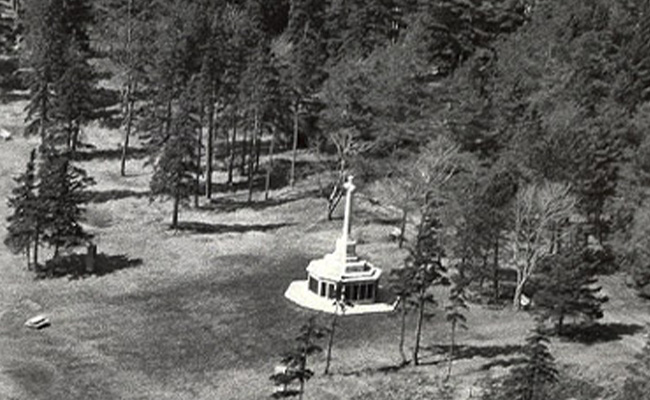
The Halifax Memorial in Nova Scotia's capital, erected in Point Pleasant Park, is one of the few tangible reminders of the Canadians who died at sea.
This memorial in Nova Scotia's capital, erected in Point Pleasant Park, is one of the few tangible reminders of the Canadians who died at sea. The monument is a great granite Cross of Sacrifice over 12 metres high, clearly visible to all ships approaching Halifax. The cross is mounted on a large podium bearing bronze panels upon which are inscribed the names of 3,257 Canadian men and women who were buried at sea. The dedicatory inscription reads as follows:
1914 - 1918, 1939 - 1945In honour of the men and women of the navy, army and merchant navy of Canada whose names are inscribed here. Their graves are unknown but their memory shall endure.

- Date modified:













